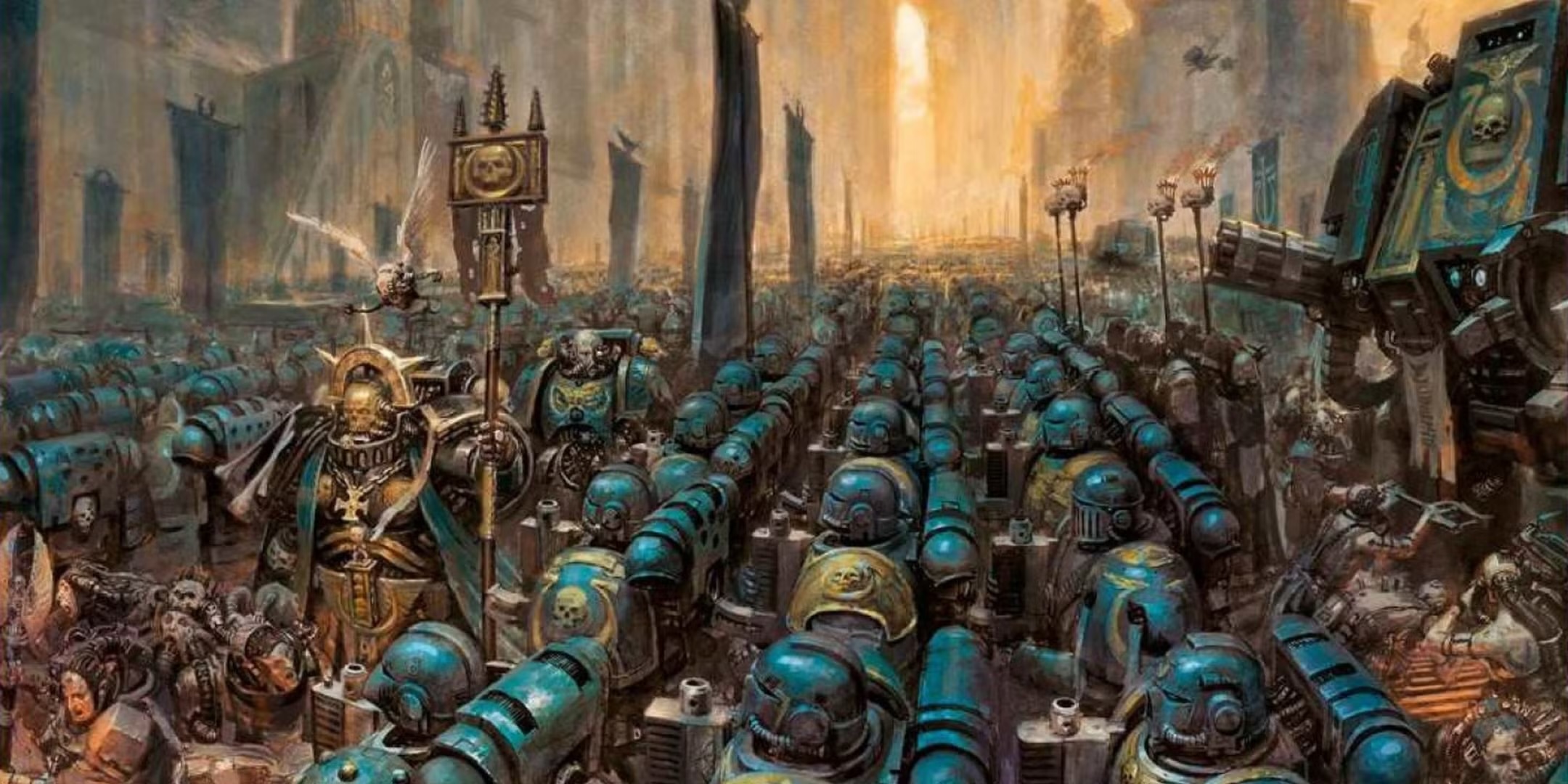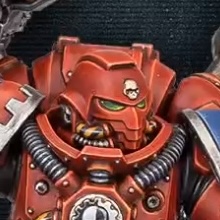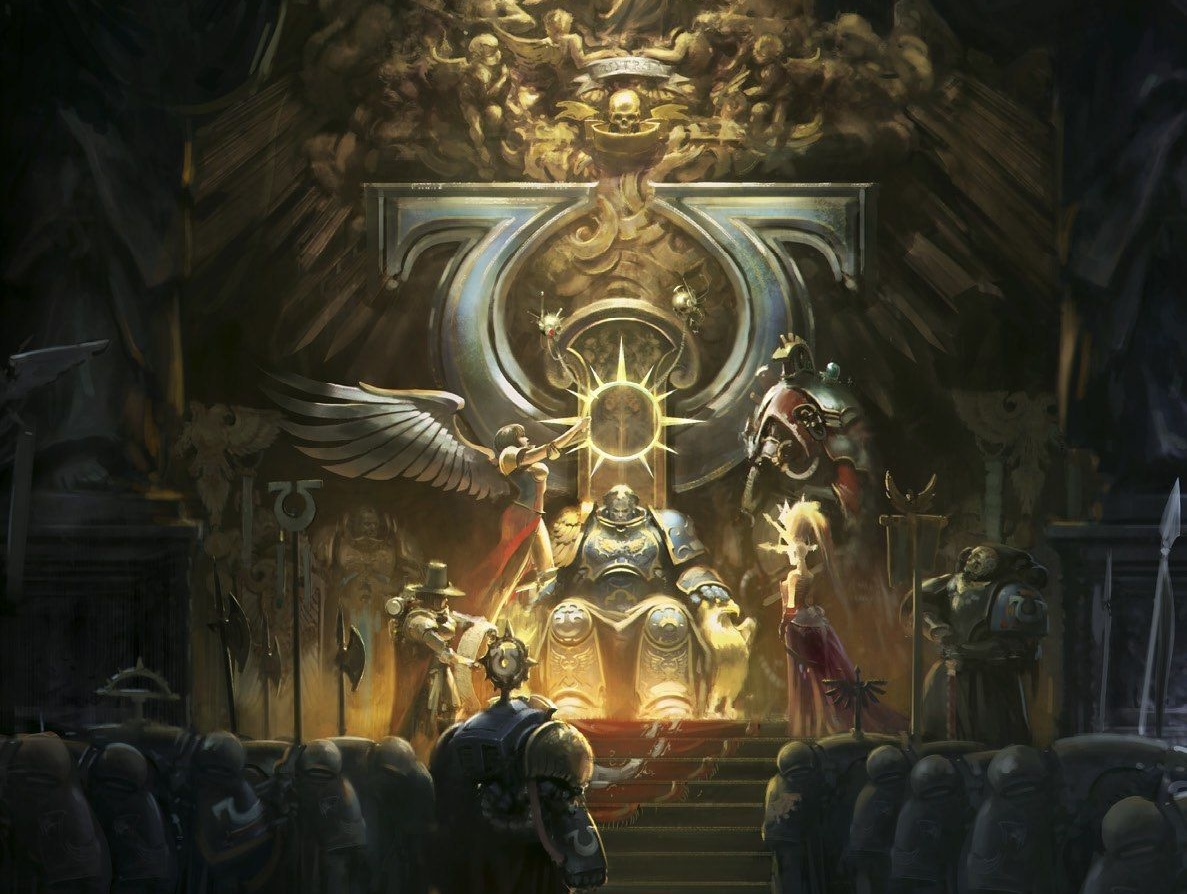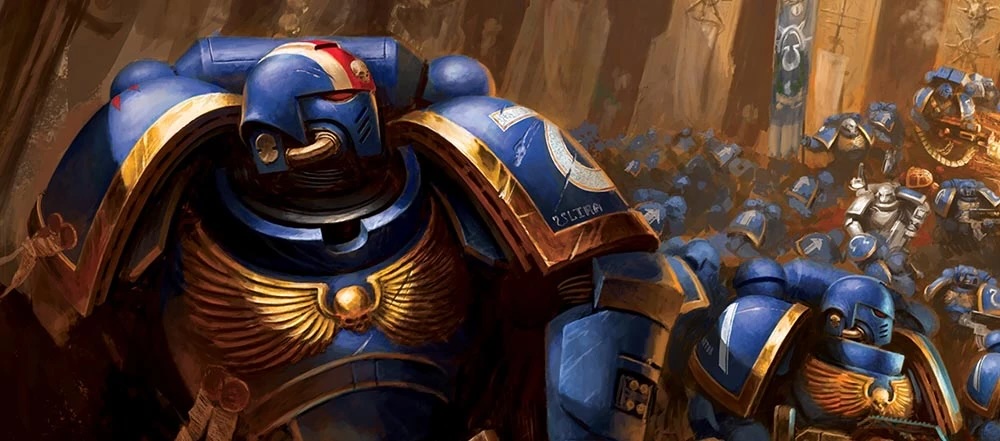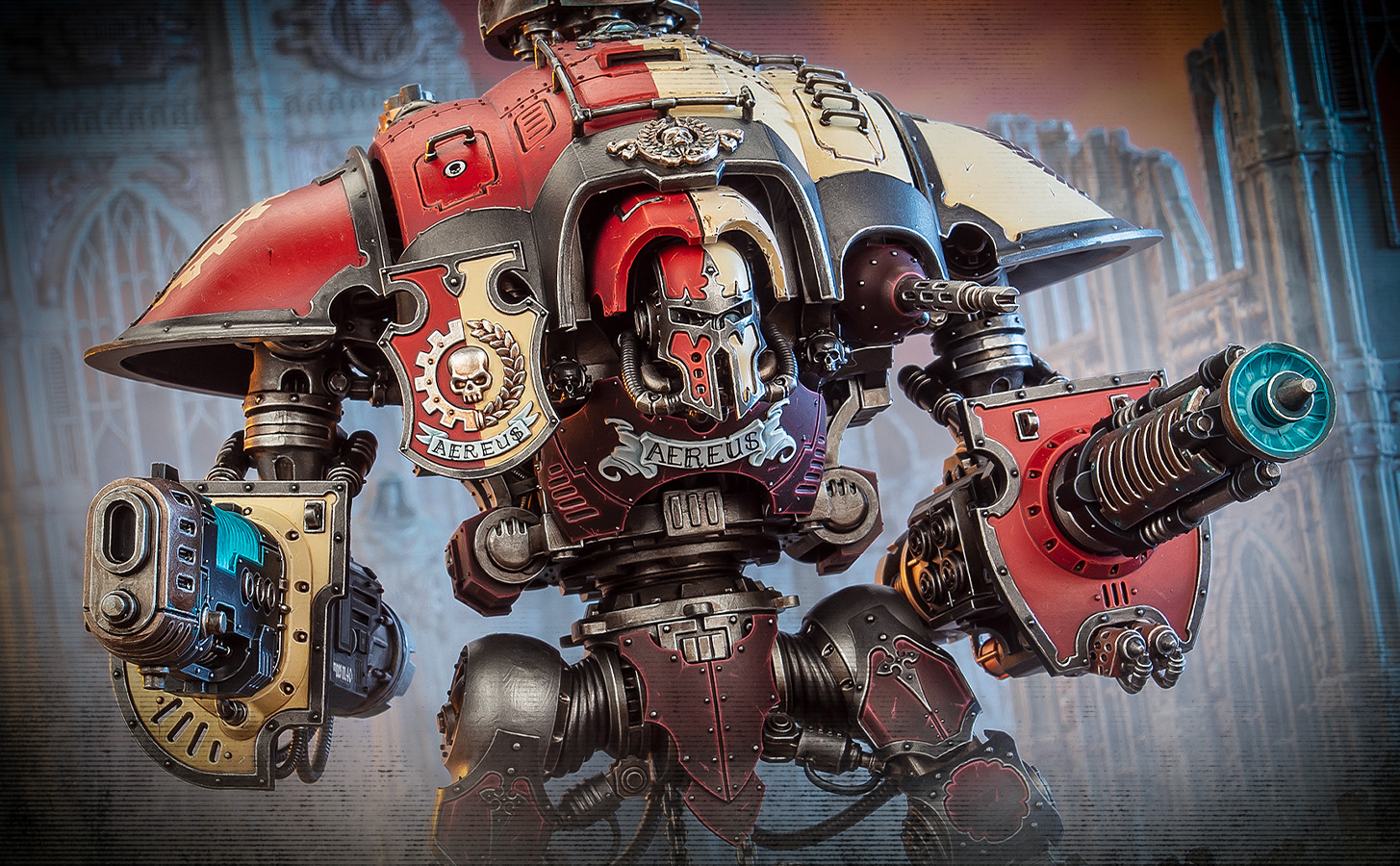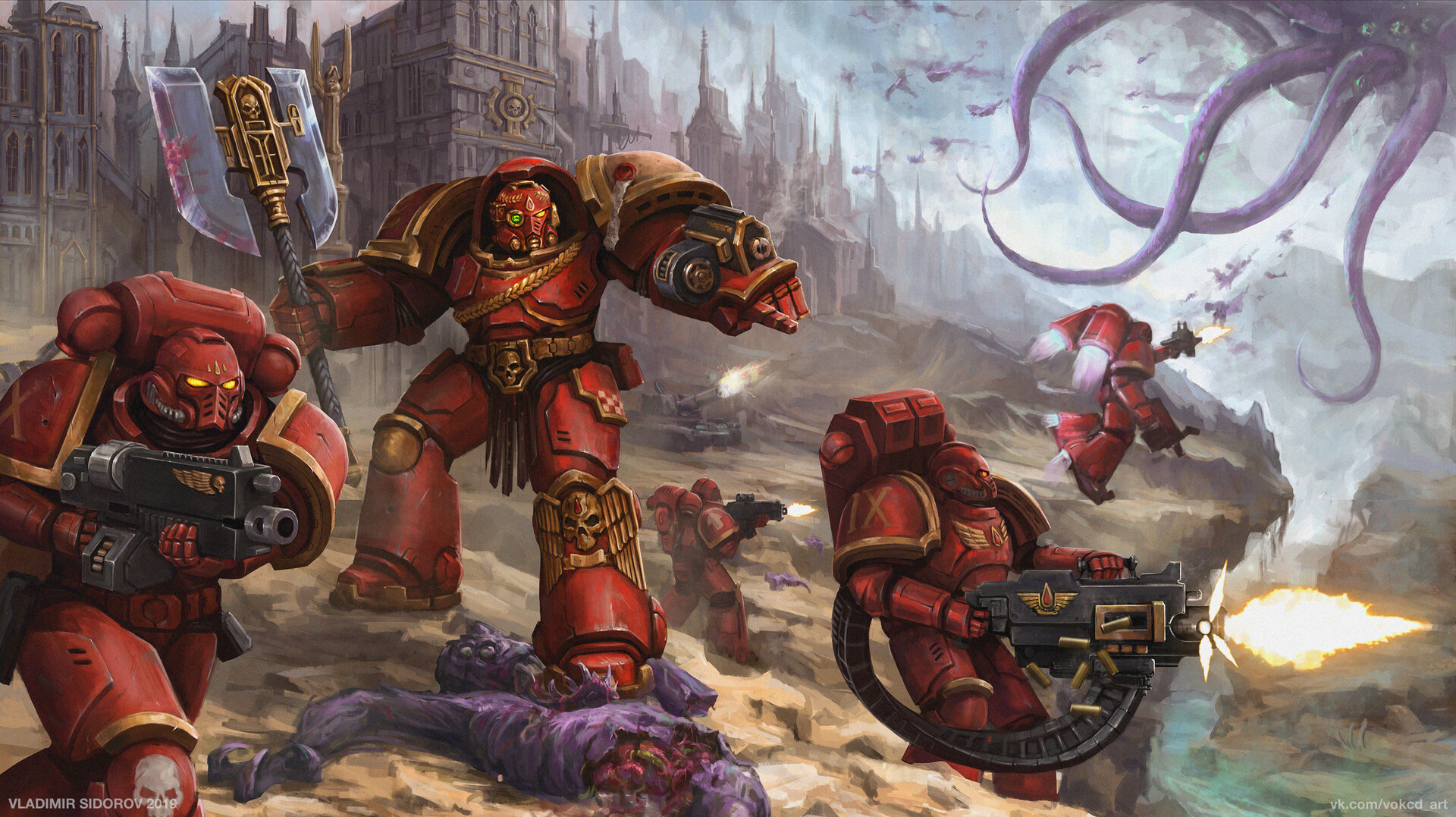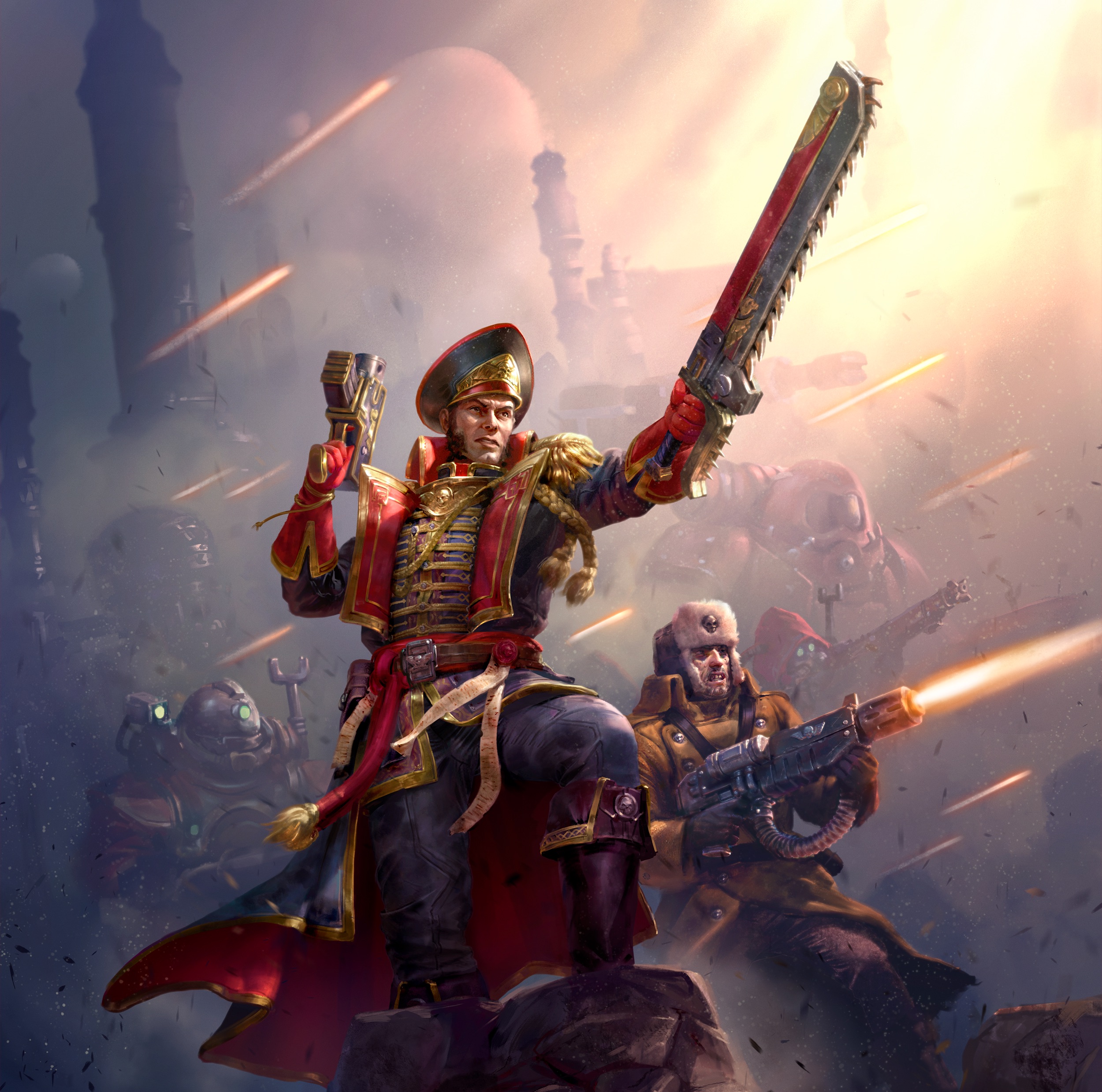Introduction
They shall be my finest warriors, these men who give of themselves to me. Like clay I shall mould them and in the furnace of war I shall forge them. They shall be of iron will and steely sinew. In great armour I shall clad them and with the mightiest weapons shall they be armed. They will be untouched by plague or disease; no sickness shall blight them. They shall have such tactics, strategies and machines that no foe will best them in battle. They are my bulwark against the Terror. They are the Defenders of Humanity. They are my Space Marines…and they shall know no fear.”
— The Emperor of Mankind
In the grim darkness of the far future, the Adeptus Astartes – better known as the Space Marines – stand immortalized as the supreme warriors of Humanity. Genetically engineered and clad in sacred power armour, they are the God-Emperor’s avenging angels, forged to be stronger, faster, and more resilient than any normal man.
Ten thousand years of unending war have only added to their legend. They know no fear and no equal on the battlefield, for they were crafted by the Emperor Himself to be the ultimate defenders of Mankind. Tales of their deeds spread across the galaxy, whispered in awe on countless worlds.
Yet the glory of the Space Marines was not won without sacrifice. Their history is a tumultuous saga – from the golden age of the Emperor’s Great Crusade, through the fiery betrayal of the Horus Heresy, to the austere rebirth of the Chapters that battle in the darkness of the 41st Millennium. What follows is an account of that epic evolution, drawn from the annals of Imperial history and the remembrance of the heralds of the Adeptus Astartes.
The Great Crusade and the Birth of the Legions
It began in the twilight of Old Night, as the Emperor of Mankind revealed Himself to a fractured Terra. Having united Terra in the bloody Unification Wars, the Emperor turned His gaze to the stars and launched the Great Crusade in the 30th Millennium. To spearhead this vast campaign of reunification, He engineered the Legiones Astartes – the original Space Marine Legions.
Twenty Space Marine Legions were created in what Imperial histories call the First Founding, each Legion born from the genetic essence of one of the Emperor’s superhuman sons, the Primarchs. These newly-forged Astartes were far superior to the Thunder Warriors of old, blessed with enhanced lifespans, discipline, and strength to endure the galaxy-spanning wars to come. As each lost Primarch was rediscovered on a distant world, the Emperor gave him command of his Legion, uniting father and son in the pursuit of Humanity’s dominion over the galaxy.
During the Great Crusade, the Space Marine Legions were at the forefront of every major campaign, the tip of the Emperor’s spear. Numbering in the tens of thousands, each Legion fought as a vast army unto itself, accompanied by the massed ranks of the Imperial Army and the Mechanicum in grand Expeditionary Fleets.
The names of these Legions became synonymous with conquest and liberation: the Ultramarines bringing orderly compliance to scattered human colonies, the Luna Wolves (later Sons of Horus) striking with unmatched cunning, the Imperial Fists fortifying and defending the Imperium’s gains, the Blood Angels unleashing noble fury, and countless others forging legends on alien battlefields.
World by world, system by system, the Emperor’s dream of a united Human galaxy took form under the relentless advance of the Legiones Astartes. It was a golden age of expansion – Humanity’s armies marched under the Aquila and worlds long lost to Old Night welcomed their saviors or felt the Emperor’s wrath if they refused. The Space Marines were not only warriors but also crusading knights and emissaries of the Imperium, bringing the Imperial Truth to all corners of the Milky Way.
Yet even in this time of triumph, there were mysteries and shadows. Imperial records note that of the twenty original Legions, two were eventually erased from all records, their names and deeds lost to time and forbidden from remembrance. Whether by tragedy or treachery, those Legions’ fates remain one of the greatest secrets of the Great Crusade.
Still, the remaining Legions and their Primarchs pressed on, each developing its own culture and methods of war as the Crusade reached its apex. By the close of the 30th Millennium, the Imperium of Man spanned a million worlds, and the Emperor’s dream of Unity seemed within reach – until the galaxy was engulfed in flames of betrayal.
The Horus Heresy and the Fall of the Legions
The Imperium’s brightest triumph turned to its darkest hour in the early 31st Millennium. At the very height of the Great Crusade, the Warmaster Horus Lupercal – once the Emperor’s most beloved and trusted son – succumbed to the corrupting whispers of Chaos.
In an act that would sunder the galaxy, Horus led fully half of the Space Marine Legions in open rebellion against the Emperor. Legions that had stood as brothers now faced each other as bitter enemies. What followed was the apocalyptic civil war known as the Horus Heresy, a conflict that raged for seven terrible years and consumed hundreds of worlds in blood and fire.
The Horus Heresy began with treachery on the dreary world of Istvaan III, where Horus purged the remaining Loyalists from his own Legion in fire, heralding the open declaration of his revolt. One by one, other Primarchs cast their lot with Horus: Angron of the World Eaters, Fulgrim of the Emperor’s Children, Mortarion of the Death Guard, Lorgar of the Word Bearers, and more – each turning their Legions against the master of mankind. These Traitor Legions massacred those who remained faithful within their ranks and carved a bloody path toward Terra.
Loyalist Legions under Primarchs like Sanguinius of the Blood Angels, Rogal Dorn of the Imperial Fists, Lion El’Jonson of the Dark Angels, and Roboute Guilliman of the Ultramarines rallied to defend the Emperor and the Imperium they had built. The galactic war that ensued was waged on an unimaginable scale: brother fought brother, demigods clashed with a fury that sundered planets, and the warp itself boiled over as the foul influence of the Chaos Gods spread across the stars.
As the Traitor forces pushed ever closer to Terra, the Imperium buckled under the onslaught. Once-loyal planets burned in the name of the Dark Gods, and entire star systems fell into anarchy. In this maelstrom of carnage, much of the truth was lost to legend – tales grew of giants striding across battlefields and the very planets splitting under the weight of their war.
What is known is that Horus’ forces eventually reached the Sol System, and the war culminated in the Siege of Terra, the most terrible battle in human history. Horus, now swollen with the power of Chaos, dared to strike at the Imperial Palace itself. The Loyalist Legions made their last stand upon the walls of the Emperor’s own sanctum, refusing to yield even as traitors and daemons besieged them from all sides.
In the final, fateful gambit, the Emperor boarded Horus’ warship – the Vengeful Spirit – alongside his brave Companions such as Sanguinius and Dorn. There, in the battle-broken throne room of the Warmaster’s flagship, the Emperor of Mankind and Horus Lupercal met for the last time. Sanguinius, the Angel, confronted Horus first and was slain, his bloodied body cast aside by the fallen Warmaster.
Empowered by Chaos beyond measure, Horus engaged the Emperor in a titanic duel that decided the fate of Humanity. Horus struck the Emperor a mortal blow, tearing apart the Master of Mankind’s flesh with blasphemous strength. But in that moment of darkest defeat, the Emperor gathered His final reserve of divine power. With a sorrowful, last stroke, the Emperor obliterated Horus – body and soul – utterly destroying His wayward son and shattering the leadership of the rebellion. The Arch-traitor was dead; the heresy he ignited was extinguished in an instant of agonizing sacrifice.
Though victory was seized, it came at unimaginable cost. The Emperor was found on the brink of death, his body broken beyond repair. He was carried, barely living, to the Golden Throne – an arcane life-sustaining device – and interred there to rule forever as the undying God-Emperor of Mankind.
The shattered Traitor Legions, their master gone, retreated howling into the warp and the Eye of Terror to escape vengeance. In the aftermath, known as the Great Scouring, the vengeful Loyalist forces hunted the traitors across the galaxy, purging the Emperor’s realm of heresy.
The Horus Heresy had ended, but the days of the great Legions were over. The Imperium lay in ruins and would have to be rebuilt from the ashes – and never again could such a civil war be allowed to occur. It was in this crucible of tragedy that the Adeptus Astartes would be reborn in a new form, thanks to the wisdom of one heroic son of the Emperor who survived that dark era.
The Codex Astartes and the Birth of the Chapters
In the wake of the Horus Heresy, the Imperium struggled to restore order from near annihilation. Of the Emperor’s sons, Roboute Guilliman, Primarch of the Ultramarines, took on the mantle of leadership as Imperial Regent, determined to prevent a disaster like the Heresy from ever happening again.
Guilliman turned his prodigious tactical mind to reorganization and recovery. Gathering the remaining Loyalist Primarchs and commanders, he proposed a bold new structure for the Space Marines. Thus was born the Codex Astartes, the sacred tome of knowledge and law that would redefine the Adeptus Astartes for the future.
The Codex Astartes, written by Guilliman’s own hand, was far more than a mere book of tactics. It codified the moral behavior, strategic doctrines, and structure of the Space Marines, distilling the hard lessons learned from the Heresy.
Its primary decree was the breaking up of the old Legion forces into smaller autonomous units known as Chapters. No longer would any single individual command the loyalty and might of an entire Space Marine Legion. Instead, each Chapter would consist of roughly one thousand warriors – a self-contained brotherhood with its own officers, fleets, and support, capable of independent operation.
This drastic measure was designed explicitly to prevent another Horus from ever rising to power. With the Legions dissolved, never again could one man lead the whole Astartes astray or wield such overwhelming force against the Imperium. As Guilliman wrote, “Never again shall the Imperium’s foes be allowed to divide us, nor shall we gather in such numbers that one man’s treachery might spell our doom.” Those words – carved into the very pages of the Codex – became the guiding principle for all future generations of Space Marines.
The transition was not without controversy. Many of Guilliman’s brother Primarchs initially balked at the idea of dividing their proud Legions. They had led these warriors through the fires of the Heresy and saw the Codex as an affront to their honor or a sign of distrust.
Rogal Dorn of the Imperial Fists was especially vocal in his opposition, believing that the Legions should remain intact to defend the weakened Imperium. Leman Russ of the Space Wolves growled that his Legion would not be split at the decree of any bureaucrat, even Guilliman.
But Guilliman, as de facto leader of the Imperium, stood firm. He argued that the security of Humanity demanded this change. One by one, most of the Loyalist Primarchs came to accept the necessity of the Codex reforms, some grudgingly, others with open arms. The Ultramarines, ever the exemplar, were the first to divide, setting the pattern for others to follow.
Within a few years of the Heresy’s end – by 021.M31, seven standard years after Horus’s death – the decree of Guilliman was implemented in what became known as the Second Founding. Each of the surviving First Founding Legions was divided into multiple Chapters. One Chapter retained the name, colors, and honors of the original Legion – for example, the Ultramarines Chapter, Imperial Fists Chapter, Blood Angels Chapter and so on – led in many cases by their Primarch or senior veterans, thereby preserving the Legion’s legacy.
The additional successor Chapters took on new names and heraldry, forging their own identities while maintaining the bloodline and traditions of their parent Legion. The Imperial Fists, for instance, gave rise to successors like the Crimson Fists and Black Templars; the Blood Angels to the Angels Encarmine, Flesh Tearers and others.
Even the Space Wolves, despite their Primarch’s grumblings, split off a single successor (the ill-fated Wolfbrothers Chapter) to comply – if only barely – with the Codex’s demands. Through the Second Founding, the Legiones Astartes were reborn as a brotherhood of Chapters scattered across the galaxy. Each Chapter was to be autonomous, responsible for its own recruitment, training, and equipment, bound to the others only by shared duty and loyalty to the Golden Throne.
The Codex Astartes became the cornerstone of Space Marine culture going forward. While not every Chapter would follow its tenets to the letter – some retained organizational quirks or unique traditions – the vast majority embraced Guilliman’s framework in spirit.
Chapters that adhered closely to the Codex’s structure and guidelines came to be known as Codex-compliant Chapters, holding Guilliman’s teachings as sacred lore. Over the millennia, many additional Foundings would occur, creating new Chapters when needed, but all traced their lineage back to the original Legions and the wisdom of the Codex.
In time, even those Primarchs who had opposed the reforms came to see their value, or at least their inevitability. The Chapter proved to be a resilient, flexible formation – large enough to be effective, small enough to prevent one person’s ambition from threatening the Imperium. In the dark centuries that followed, this new structure would be tested again and again, but it endures to this day, nearly ten thousand years later.
The Modern Adeptus Astartes
Now, in the waning years of the 41st Millennium, the Adeptus Astartes continue to fulfill their sacred role as the Angels of Death and protectors of the Imperium. The once vast Legions are long gone, replaced by roughly a thousand Space Marine Chapters, each an independent brotherhood of up to one thousand battle-brothers.
Scattered across the stars, these Chapters guard the Imperium from every threat imaginable. Their fortress-monasteries crown distant worlds or float as mighty battle-barges in the void, serving as headquarters from which the Chapter Master and his council direct their forces.
Each Chapter is its own proud dynasty, carrying on the genetic heritage of its Primarch and the customs of its founding Legion. The Ultramarines and their successors exemplify strict adherence to the Codex Astartes in organization and tactics, while others like the Space Wolves or Blood Angels diverge in certain ways – yet all are united in devotion to the Emperor and the defense of Mankind.
Though ten thousand years have passed since the Heresy, a Space Marine of the modern era is physically and psychologically not far removed from his Legionary forebears. They still undergo the same rigorous gene-seed implantation and indoctrination, transforming a mortal recruit into an Astartes – a transhuman killing machine.
The technology of their wargear has changed only superficially: many Marines still don the revered patterns of power armour that their ancestors wore in the Great Crusade, each suit a treasured relic of a more glorious age. The Chapter remains the primary instrument of Space Marine deployment, each a self-contained army with its own fleet, armory, and support staff.
However, in the grand scale of the Imperium, the Astartes are few. Perhaps one million Space Marines in total stand against a galaxy of innumerable horrors. They are too scarce to garrison every world or fight protracted wars of occupation – those duties fall to the billions of the Astra Militarum (Imperial Guard).
Instead, the Adeptus Astartes strike where the battle is fiercest, where the stakes are highest, acting as the Emperor’s scalpel (and occasionally His hammer) to crush threats that conventional forces cannot handle. Rapid strike forces, orbital drops, sudden decapitation assaults – these are the ways of the Space Marines. In a universe brimming with xenos hordes, heretic warbands, and daemonic incursions, the Chapters deploy as elite shock troops, appearing without warning at the pivotal moment to turn the tide of war through superior skill, genetics, and unwavering faith.
Yet the modern Space Marine is more than just a weapon. Each Chapter is also a monastic warrior order, bound by sacred oaths and traditions dating back to the Heresy and the Great Crusade. They venerate the Emperor (now worshipped as the God-Emperor) as a divine figure and honor their Primarch progenitors as saints and heroes.
In their rituals and doctrines, the lessons of the past live on – every battle-brother knows the cautionary tale of Horus’ Fall, and the debt they owe to Guilliman’s wisdom. The Codex Astartes is still consulted as holy writ by many Chapters, its words guiding their strategies and battlefield conduct. For others who diverge from the Codex, their own charters and traditions serve a similar role.
For example, the Space Wolves follow the edicts of their Primarch Leman Russ and the sagas of Fenris more than Guilliman’s book, yet even they unconsciously uphold the Codex’s intent by never growing beyond the size of a Chapter. In all cases, discipline and loyalty are the utmost virtues.
A Space Marine is conditioned to be unyielding and incorruptible – though tragically, the galaxy has shown that some Chapters have still fallen to treachery in the millennia since (the Blood Angels’ brush with the Black Rage, the tragic fall of the Astral Claws into the cursed Red Corsairs, and others serve as eternal warnings). Most however remain forever loyal, the shining knights of Humanity amidst a sea of darkness.
Every Chapter fights its own endless war. The Ultramarines patrol the realm of Ultramar against alien invaders from the Eastern Fringe. The Dark Angels hunt the scattered Fallen in penitent secrecy. The Space Wolves range from Fenris to punish the foes of mankind with fang and fury. The Black Templars crusade across the stars, never resting in their holy war. The Salamanders, Imperial Fists, White Scars, and all the others – each carries a piece of the Emperor’s Great Crusade in their hearts, each determined to uphold humanity’s light against the encroaching night.
In the 41st Millennium, the Imperium faces threats unimagined by the Legionaries of old: tyranid hive fleets that devour entire systems, undying Necron dynasties rising from aeons of sleep, the eternal menace of Chaos ever plotting from the Eye of Terror, and the upstart Tau Empire at the fringes of the galaxy. Amidst cosmic storms that tear the sky and the birth of new wars without end, the Adeptus Astartes stand unyielding. They are the shield and the sword of the Imperium – the Angels of Death, transcending myth to fight in the Emperor’s name as they have since the days of legend.
Conclusion
From the Legions of the Great Crusade to the Chapters of the grim present, the saga of the Adeptus Astartes is written in the blood of heroes and the fate of worlds. Each evolution in their structure was purchased with immeasurable sacrifice: the Legions forged the Imperium in humanity’s golden age, the Heresy nearly destroyed all they had built, and the rebirth of the Chapters ensured the survival of the Imperium in a new form.
The legacy of the Space Marines thus endures, stronger than any one hero or Legion. Every modern Space Marine Chapter is a living legacy of that bygone era – each Chapter’s gene-seed a direct lineage to a Primarch, each battle cry an echo of ancient oaths sworn on Terra’s dusty plains or the fields of Ullanor long ago. The Codex Astartes, born of Guilliman’s foresight, remains a vital chain linking the nobility of the past to the exigencies of the present.
It is often said that “the Space Marines are the Imperium’s last resort, its ultimate weapon.” In the Age of the Imperium, beset on all sides by nightmares without end, this rings true. There are never enough of them, yet somehow the Adeptus Astartes are always there when desperately needed, appearing as angels in humanity’s darkest hours.
Ten millennia have passed since the Emperor walked among His Legions, yet His sons still wage war in His name. The Adeptus Astartes continue to stand vigil over the Imperium – immortal warriors in a galaxy of endless war. They remember the triumphs and tragedies that shaped them: the vision of Unity that birthed the Legions, the pain of brother fighting brother in the Heresy, and the solemn duty laid upon the Chapters thereafter.
Each Chapter, whether bound by the Codex or guided by its own revered traditions, strives to uphold the ideals for which the Emperor nearly gave His life. On countless battlefields in this dark millennium, the Space Marines fight not just with bolter and blade, but with the weight of history driving them onward. They know that failure is unthinkable – for if the Adeptus Astartes falter, the Imperium’s downfall would surely follow.
And so, the Chapter warriors of the 41st Millennium shoulder the same burden their forefathers did: to be the shield against the Terror and the bringers of wrath to the enemies of mankind. In their courage and self-sacrifice, the spirit of the Emperor’s Legions lives on. The Adeptus Astartes are more than flesh and ceramite; they are an ideal made manifest – the Emperor’s will incarnate.
As legends say, they shall be His finest warriors and shall know no fear, now and forever. In the ever-darkening night of war, the Space Marines remain a blazing beacon of hope and defiance. Their legacy is eternal, their honor undimmed. From the ashes of the Horus Heresy to the battlefields of the 41st Millennium, the Adeptus Astartes stand unbroken – the mighty saviors of Humanity until the end of time.
